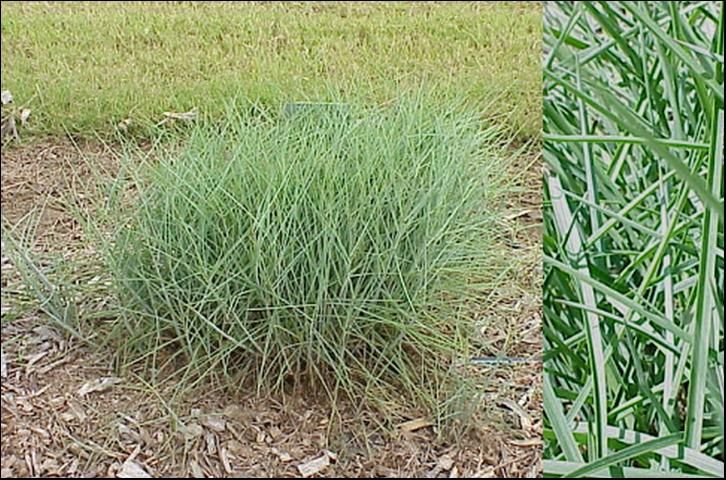
Credit: Photo by Mack Thetford.
Gulf bluestem (Schizachyrium maritimum Chapman (Nash [Poaceae]), is considered to be the most important species of bluestem grass on the Gulf of Mexico and occurs primarily on dunes, beaches, and coastal swales (Craig 1991). Following the formation of a more seaward ridge, gulf bluestem replaces sea oats (Uniola paniculata L. [Poaceae]) on the newly protected primary ridge within 2 to17 years (Johnson 1997). This plant is a candidate for beach projects requiring planting on the back side of a primary dune, or any side of secondary dunes, or for commercial or home landscapes. This prostrate or creeping perennial spreads by long stolons and is easily distinguished by glaucous leaves, prostrate growth habit, and terminal inflorescences with stalked spikelets from 4.0 to 6.5 mm (0.15 to 0.26 in) (Clewell 1985).
Softwood cuttings may be collected during the growing season and placed in plastic bags or stored in a cooler for transport. Cuttings may be prepared from terminal shoots representing the first 8 inches of each shoot. These terminal shoots may be bisected to produce 4-inch cuttings but segregation of the proximal portions (basal portions) and distal portions (terminal bud intact) will be important. It is not necessary to remove foliage from the base of the cuttings. The base of each cutting may be treated with a quick dip of an auxin solution for 1 second followed by 15 minutes of air drying, or treatment with a talc-based auxin before insertion to a 1/2 to 3/4 inch depth. Cuttings may be propagated in small pots or nursery flats with inserts divided into individual cells. Well-drained propagation mixes should be used to ensure sufficient oxygen in the rooting zone. Research has shown rooting success with pinebark-based substrates or potting mixes containing a mixture of sphagnum peat moss, horticultural perlite and vermiculite (Thetford and Miller 2002). Cuttings should not be allowed to dry and the best method to retain moisture is the use of an intermittent mist operated daily. Cuttings may be maintained under natural photoperiod.
Proximal cuttings (basal portions of the stems) of gulf bluestem may be rooted without auxin and one may expect rooting percentages around 80%. Research has shown no effect of auxin application on root number, mean root length, or number of tillers produced per rooted cutting. However, cutting type (proximal versus distal) is very important for this species and will influence the percentage of cuttings with roots. Rooting percentage will be greatest for proximal (basal) cuttings while distal cuttings (prepared from stem terminals) root very poorly. Although auxin application to distal cuttings has been shown to double the rooting percentage, only 34% of terminal cuttings actually produce roots. Terminal cuttings often have a limited number of mature nodes (the primary site of root initiation in cuttings of gulf bluestem) which contributes to low rooting percentages. Given the low rooting percentage for plants produced from distal (terminal) cuttings (16% to 34%), it may be advisable to grade cuttings and discard terminals.
A production schedule for this species in spring and summer months will begin with cuttings stuck in a pinebark-based substrate such as 100% milled pine bark or a commercial planting mix. Many commercial growers will use 72-cell trays with roots initiating within 2 to 3 weeks. Rooted cuttings are removed from the mist on week 3 or 4 and plants remain in the propagation flats through weeks 5 to 6. Plants are irrigated as needed 2 to 3 times each week. Nutritional status of the plants is maintained by liquid fertilization (1 to 2 times each week) with a 150 ppm N solution from products such as Peters 20 N:10 P2O5:20 K2O (JR Peters, Inc, Allentown, PA 18106). Gulf bluestem, in general, will not require pruning to initiate branching. Following transplant into 4-inch or 1-quart pots, plants require an additional 4- to 6-week production period to achieve a full rootball and a canopy of approximately 6 to 8 inches.
References
Clewel, A. F. 1985. Guide to the Vascular Plants of the Florida Panhandle. University Presses of Florida, Florida State University Press. Tallahassee. p.158–159.
Craig, R. M. 1991. "Plants for Coastal Dunes of the Gulf and South Atlantic Coasts and Puerto Rico." United States Department of Agriculture Soil Conservation Service Agriculture Information Bulletin 460. 41 pages.
Johnson, A. F. 1997. "Rates of Vegetation Succession on a Coastal Dune System in Northwest Florida." Journal of Coastal Research 13: 373–384.
Thetford, Mack and Debbie Miller. 2002. "Propagation of 4 Florida Coastal Dune Species." Native Plants Journal Vol. 3(2):112–120.